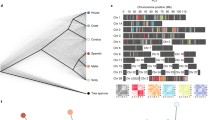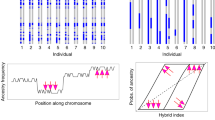Abstract
Introgressive hybridization facilitates incorporation of genes from one species into the gene pool of another. Studies on long-term effects of introgressive hybridization in animal systems are sparse.Drosophila nasuta (2n = 8) andD. albomicans (2n = 6)—a pair of allopatric, morphologically almost identical, cross-fertile members of thenasuta subgroup of theimmigrans species group-constitute an excellent system to analyse the impact of hybridization followed by transgressive segregation of parental characters in the hybrid progeny. Hybrid populations ofD. nasuta andD. albomicans maintained for over 500 generations in the laboratory constitute new recombinant hybrid genomes, here termed cytoraces. The impact of hybridization, followed by introgression and transgressive segregation, on chromosomal constitution and karyotypes, some fitness parameters, isozymes, components of mating behaviour and mating preference reveals a complex pattern of interracial divergence among parental species and cytoraces. This assemblage of characters in different combinations in a laboratory hybrid zone allows us to study the emergence of new genetic systems. Here, we summarize results from our ongoing studies comparing these hybrid cytoraces with the parental species, and discuss the implications of these findings for our understanding of the evolution of new genetic systems.
Similar content being viewed by others
References
Anderson E. 1949Introgressive hybridization. Wiley, New York.
Anderson W. W. and Stebbins G. L. 1954 Hybridization as an evolutionary stimulus.Evolution 8, 378–388.
Arnold M. L. 1997Natural hybridization and evolution. Oxford University Press. New York.
Aruna S and Ranganath H. A. 2004 Isozymes and genetic divergence in thenasuta-albomicans complex ofDrosophila. Curr. Sci. (in press).
Avise J. C. 1994Molecular markers, natural history and evolution. Chapman and Hall, New York.
Barton N. H. 2001 The role of hybridization in evolution.Mol. Ecol. 10, 551–568.
Barton N. H. and Hewitt G. M. 1989 Adaptation, speciation and hybrid zones.Nature 341, 497–503.
Bock I. R. 1984 Interspecific hybridization in the genusDrosophila.Evol. Biol. 18, 41–70.
Bruke J. M. and Arnold M. L. 2001 Genetics and the fitness of hybrids.Annu. Rev. Genet. 35, 31–52.
Carson H. L. 1982 Evolution ofDrosophila on the newer Hawaiian volcanoes.Heredity 48, 3–25.
Chang H. and Ayala F. J. 1989 On the origin of incipient reproductive isolation: the case ofDrosophila albomicans andDrosophila nasuta.Evolution 43, 1614–1624.
Chang H., Wang D. and Ayala F. J. 1989 Mitochondrial DNA evolution in theDrosophila nasuta subgroup of species.J. Mol. Evol. 28, 337–348.
Charlesworth B. 1996 The evolution of chromosomal sex determination and dosage compensation.Curr. Biol. 6, 149–162.
Charlesworth B., Charlesworth D., Hnilicka J., Yu A. and Guttman D. S. 1997 Lack of degeneration of loci on the neo-Y chromosome ofDrosophila americana americana.Genetics 145, 989–1002.
Cracraft J. 1983 Species concepts and speciation analyses.Curr. Ornithol. 1, 159–187.
Cruzan M. B. and Arnold M. L. 1993 Ecological and genetic associations in anIris hybrid zone.Evolution 47, 1432–1445.
De Pamphilis C. W. and Wyatt R. 1990 Electrophoretic confirmation of interspecific hybridization inAesculus (Hippocastanaceae) and the genetic structure of a broad hybrid zone.Evolution 44, 1295–1317.
Dobzansky Th. 1949 Observations and experiments on natural populations inDrosophila. (Proceedings of the 8th International Congress of Genetics 1948)Hereditas (suppl. vol.) 210–224.
Dobzhansky Th. 1970a Speciation as a stage in evolutionary divergence.Am. Nat. 74, 312–321.
Dobzhansky Th. 1970bThe genetics of the evolutionary process. Columbia University Press, New York.
Fritz R. S. 1999 Hybridization and resistance to parasites.Ecology 80, 359–360.
Goodman S. J., Barton N. H., Swanson G., Abernethy K. and Pemberton J. M. 1999 Introgression through rare hybridization: a genetic study of a hybrid zone between red and sika deer (Genus:Cervus), in Argyll, Scotland.Genetics 152, 355–371.
HÄgele K. and Ranganath H. A. 1982 The chromosomes of twoDrosophila races:D. nasuta nasuta andD. nasuta albomicana. II. Differences in their microchromosomes.Chromosoma 85, 215–220.
HÄgele K. and Ranganath H. A. 1983 The chromosomes of twoDrosophila races:D. nasuta nasuta andD. nasuta albomicana. III. Localization of nucleolar organizer regions.Genetica 60, 123–128.
Haldane J. B. S. 1922 Sex-ratio and unisexual sterility in hybrid animals.J. Genet. 12, 101–109.
Harrison R. S. 1990 Hybrid zones: windows on evolutionary process.Oxf. Surv. Evol. Biol. 7, 158–167.
Hewitt G. M. 1988 Hybrid zones-natural laboratories for evolutionary studies.Trends Ecol. Evol. 3, 158–167.
King M. 1993Species evolution: the role of chromosome change. Cambridge University Press, Cambridge.
Kitagawa O., Wakahama K., Fuyama Y., Shimada Y., Takanashi E., Hatsumi M., Uwabo M. and Mita Y. 1982 Genetic studies of theDrosophila nasuta subgroup, with notes on distribution and morphology.Jpn. J. Genet. 57, 113–141.
Lucchesi J. C. 1978 Gene dosage compensation and the evolution of sex chromosomes.Science 202, 711–716.
McAllister B. F. 2002 Chromosomal and allelic variation inDrosophila americana: selective maintenance of a chromosomal cline.Genome 45, 13–21.
Mahesh G., Ramachandra N. B. and Ranganath H. A. 2000 Patterns of replication in the neo-sex chromosomes ofDrosophila nasuta albomicans.J. Biosci. 25, 229–234.
Mahesh G., Ramachandra N. B. and Ranganath H. A. 2001 Autoradiographic study of transcription and dosage compensation in the sex and neo-sex chromosomes ofD. n. nasuta andD. n. albomicans.Genome 44, 71–78.
Marin I., Siegal M. L. and Baker B. S. 2000 The evolution of dosage-compensation mechanisms.BioEssays 22, 1106–1114.
Mayr E. 1963Animal species and evolution. Belknap Press of Harvard University, Cambridge.
Muller H. J. 1918 Genetic variability, twin hybrids and constant hybrids in a case of balanced lethal factors.Genetics 93, 422–499.
Nei M. 1972 Genetic distance between populations.Am. Nat. 106, 283–292.
Nirmala S. S. and Krishnamurthy N. B. 1972Drosophila albomicans -a race ofDrosophila nasuta.Drosoph. Inf. Serv. 49, 60.
Patterson J. T. and Stone W. S. 1952Evolution in the genus Drosophila. Macmillan, New York.
Price D. K. and Boake C. R. B. 1995 Behavioral reproductive isolation inDrosophila silvestris, D. heteroneura, and their F1 hybrids (Diptera,Drosophilidae).J. Insect Behav. 8, 595–616.
Rajasekarasetty M. R., Siddaveere Gowda L., Krishnamurthy N. B. and Ranganath H. A. 1979 Population genetics ofDrosophila nasuta nasuta, Drosophila nasuta albomicana and their hybrids. I. Karyotypic mosaicism in hybrid populations,Genetics 93, 211–215.
Ramachandra N. B. and Ranganath H. A. 1985 The chromosomes of two races:Drosophila nasuta nasuta andDrosophila nasuta albomicana: IV. Hybridization karyotype repatterning.Chromosoma 93, 243–248.
Ramachandra N. B. and Ranganath H. A. 1987 Mating preference betweenDrosophila nasuta nasuta andD. nasuta albomicana.Indian J. Exp. Biol. 25, 55–57.
Ramachandra N. B. and Ranganath H. A. 1988 Estimation of population fitness of parental races (Drosophila nasuta nasuta, Drosophila nasuta albomicana) and of the newly evolved Cytoraces (I and II)-the products of parental interracial hybridization.Genome 30, 58–62.
Ramachandra N. B. and Ranganath H. A. 1990 The chromosomes of twoDrosophila races:Drosophila nasuta nasuta andDrosophila nasuta albomicana: V. Introgression and the evolution of new karyotypes.Z. Zool. Syst. Evolutionsforsch. 28, 62–68.
Ramachandra N. B. and Ranganath H. A. 1996 Evolution of the nasuta-albomicans complex ofDrosophila.Curr. Sci. 71, 515–517.
Ranganath H. A. 1978 Population genetics ofDrosophila nasuta nasuta andDrosophila nasuta albomicana and their hybrids (Science Academy Medals for Young Scientists Lectures).Proc. Indian Natl. Sci. Acad. 124–139.
Ranganath H. A. 2002 Evolutionary biology ofDrosophila nasuta andDrosophila albomicans. Proc.Indian Natl. Sci. Acad. B68, 255–272.
Ranganath H. A. and HÄgele K. 1981 Karyotypic orthoselection inDrosophila.Naturwisssenschaften 68, 527–528.
Ranganath H. A. and HÄgele K. 1982 The chromosomes of twoDrosophila races:D. nasuta nasuta andD. nasuta albomicans. I. Distribution and differentiation of heterochromatin.Chromosoma 85, 83–92.
Ranganath H. A. and Krishnamurthy N. B. 1981 Population genetics ofDrosophila nasuta nasuta, D. nasuta albomicana and their hybrids. IV. Pattern of meiotic F1 chromosome segregation.J. Hered. 72, 19–21.
Ranganath H. A. and Ramachandra N. B. 1987 Chromosomal basis of raciation in Drosophila: A study withDrosophila nasuta andDrosophila albomicans.Proc. Indian Acad. Sci. Anim. Sci. 96, 451–459.
Ranganath H. A. and Ramachandra N. B. 1994Drosophila albomicans-a unique karyotype.The Nucleus 37, 105–112.
Ranganath H. A., Rajasekarasetty M. R. and Krishnamurthy N.B. 1974 Evolutionary status of IndianDrosophila nasuta.Indian J. Hered. 6, 19–25.
Ranganath H. A., Schmidt E. R. and HÄgele K. 1982 Satellite DNA ofDrosophila nasuta nasuta andD. nasuta albomicana: localization in polytene and metaphase chromosomes.Chromosoma 85, 361–368.
Rao P. and Ranganath H. A. 1990 Karyotype differentiation among members of theimmigrans species group ofDrosophila.Genetica 83, 145–152.
Rice W. R. 1996a Degeneration of a non-recombining chromosome.Science 263, 230–232.
Rice W. R. 1996b Evolution of the Y sex chromosome in animals: Y-chromosomes evolve through the degeneration of autosomes.Bioscience 46, 331–343.
Rieseberg L. H. and Carney S. E. 1998 Transley review no. 102. Plant hybridization.New Phytol. 140, 599–624.
Rieseberg L. H. and Wendel J. F. 1993 Introgression and its consequences in plants. InHybrid zones and the evolutionary process (ed. R. G. Harrison), pp. 70–113. Oxford University Press, New York.
Rieseberg L. H., Sinverno B., Linder C. R., Ungerer M. C. and Arrias D. M. 1996 Role of gene interactions in hybrid speciation: evidences from ancient and experimental hybrids.Science 272, 741–745.
Rieseberg L. H., Archer M. A. and Wayne R. K. 1999 Transgressive segregation, adaptation and speciation.Heredity 83, 363–372.
Scribner K. T. 1993 Hybrid zone dynamics are influenced by genotype-specific variation in life-history traits: experimental evidence from hybridizingGambusa species.Evolution 47, 632–646.
Searle J. B. 1998 Speciation, chromosomes and genomes.Genome Res. 8, 1–3.
Shaw D. D. and Wilkinson P. 1980 Chromosome differentiation, hybrid breakdown and the maintenance of a narrow hybrid zone inCaledia.Chromosoma 80, 1–31.
Soltis P. 1985 Studies of genetic variation in an introgressive complex inClarkia (Oragyaceae). Ph. D. thesis, University of Kansas, Lawrence, USA.
Spieth H. T. 1968 Evolutionary implications of sexual behaviour inDrosophila. InEvolutionary biology (ed. Th. Dobzhansky, M. K. Hecht and W. C. Streere), vol. 2, pp. 157–191. Appleton Century Crofts, New York.
Stebbins G. L. 1973Process of organic evolution. Prentice-Hall of India, New Delhi.
Steinemann M. and Steinemann S. 1997 The enigma of Y chromosome: TRAM, a novel retrotransposon is preferentially located on the Neo-Y chromosome ofDrosophila miranda.Genetics 145, 261–266.
Tanuja M. T. 2000 Studies on karyotype, fitness and mating preference of a few members of thenasuta-albomicans complex ofDrosophila. Ph. D. thesis, University of Mysore, Mysore, India.
Tanuja M. T., Ramachandra N. B. and Ranganath H. A. 1998 Creation of a hybrid zone inDrosophila with ’allo-sympatric’ races.Curr. Sci. 75, 1116–1117.
Tanuja M. T., Ramachandra N. B. and Ranganath H. A. 1999a Evolution of a recent neo-Y sex chromosome in a laboratory population ofDrosophila.J. Genet. 78, 81–85.
Tanuja M. T., Ramachandra N. B. and Ranganath H. A. 1999b Evolution of a new chromosomal lineage in a laboratory population ofDrosophila through centric fission.J. Biosci. 24, 421–426.
Tanuja M. T., Ramachandra N. B. and Ranganath H. A. 2001a Incipient sexual isolation in thenasuta-albomicans complex of Drosophila: no-choice experiments.J. Biosci. 26, 71–76.
Tanuja M. T., Ramachandra N. B. and Ranganath H. A. 2001b Incipient sexual isolation in thenasuta-albomicans complex of Drosophila: mating preference in male-, female-, and multiple-choice mating experiments.J. Biosci. 26, 365–371.
Tanuja M. T., Ramachandra N. B. and Ranganath H. A. 2003 Hybridization and introgression of the genomes ofDrosophila nasuta andDrosophila albomicans: evolution of new karyotypes.Genome 46, 605–611.
Templeton A. R. 1981 Mechanisms of speciation-a population genetic approach.Annu. Rev. Ecol. Syst. 12, 23–48.
Throckmorton L. H. 1982 Thevirilis species group. InThe genetics and biology of Drosophila (ed. M. Ashburner, H. L. Carson and J. N. Thompson Jr), vol. 3b, pp. 227–296. Academic Press, London.
Wasserman M. 1982 Evolution in therepleta group. InThe genetics and biology of Drosophila (ed. M. Ashburner, H. L. Carson and J. N. Thompson Jr), vol. 3b, pp. 61–139. Academic Press, London.
White M. J. D. 1973Animal cytology and evolution, 3rd edition. Cambridge University Press, Cambridge.
White M. J. D. 1978Modes of speciation. Freeman, San Francisco.
Wilson F. D., Wheeler M. R., Margaret H. and Kambysellis M. 1969 Cytogenetics relations in theDrosophila nasuta subgroup of theimmigrans group of species.Univ. Tex. Publ. 6918, 207–254.
Woodruff D. S. 1989 Genetic anomalies associated withCerion hybrid zones: the origin and maintenance of the new electromorphic variants called hybrizymes.Biol. J. Linn. Soc. 36, 281–294.
Yu Y., Lin F. and Chang H. 1997 Karyotype polymorphism in hybrid populations ofDrosophila nasuta andDrosophila albomicans.Zool. Studies 36, 251–259.
Author information
Authors and Affiliations
Corresponding author
Additional information
This paper is dedicated to the memory of our teacher, Prof. N. B. Krishnamurthy.
Rights and permissions
About this article
Cite this article
Ranganath, H.A., Aruna, S. Hybridization, transgressive segregation and evolution of new genetic systems inDrosophila . J Genet 82, 163–177 (2003). https://doi.org/10.1007/BF02715816
Issue Date:
DOI: https://doi.org/10.1007/BF02715816




